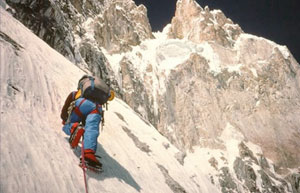Joe Simpson
Thank god for the Concept2 in the cellar. Think best way to get up the hill would be to approach it sitting down facing backwards!
Joe Simpson
Talking to TRC's Alex Skelton
In 1985 I became well known for falling off a mountain and crawling home. The crawling was a result of injuries to my right leg. I had suffered a rare fracture of the articular surface of the tibia - what is known in the medical world as a Schatzker type IV medial tibial plateau fracture - and in the climbing world as really, really painful. These form only 5% of tibial fractures. Since the laterally directed forces that cause such injuries tend to be much more violent, damage to the surrounding joint can be severe.
The impact devastated the knee joint. It completely destroyed both of my meniscus cartilages, crushed between femur and tibia, caused disruption of the anterior cruciate and medial collateral ligaments, and also damaged the fibular head and peroneal nerve. To complicate things further I had also fractured the ankle and the heel of the same leg but didn't notice at the time as I had quite a lot on my mind.
In the end I had six operations on the knee. My surgeon told me that I would only attain 5 degrees of flexion in the joint and would have a permanent limp and absolutely no hope of climbing again. The long term prognosis was of developing post-traumatic osteoarthritis as a result of ligamentous injuries with resultant instability as well as articular discongruities, biomechanical alteration of normal compressive forces, and cartilage damage. He told me this would cause greater than normal stress on the remaining support structures of the joint, misalignments, and the development of premature osteoarthritis. He really cheered me up no end.
A visit to a specialist physiotherapist convinced me that it was possible to prove the orthopaedic consultant wrong. However nine months in plaster and twelve months on crutches had left my leg almost without muscle. Training was the only solution and initially it was almost impossible, given the limited movement and feebleness of the thigh. Wading widths in the local swimming baths and long distance swimming sessions began to strengthen the leg. Then it was into the gym to grunt it out on the weights machines. The strength and power began to return and with intensive physio the flexion gradually increased, but to climb mountains again I needed a lot more than muscle power.
Mountain climbing needed stamina and excellent aerobic fitness and I couldn't get that on a weights machine. I knew from then on that the days of plonking up hills and, more to the point, hammering down them had to be limited. The knee simply would not take that sort of punishment; the damage had been too severe. I could not do high impact training. It was at this point that I developed my love-hate relationship with Concept2 rowing machines. Love - because they are fantastic low impact high result training devices and without doubt the best rowing machines available. Legs, back, chest, arms, lungs and heart are all worked hard. Hate - because of the last sentence!
Combining rowing with cycling and swimming for flexibility I eventually returned to the mountains after two years of hard rehab work. Then disaster struck again. In 1991, six years after the fall in Peru, I was again severely injured in a seven hundred foot fall on a mountain called Pachermo on the Nepalese-Tibet border.

While being rendered blissfully unconscious at the end of the fall I sustained a laterally comminuted fracture-dislocation of the left ankle. This is a highly unstable injury in which anatomical reduction of the talus and restoration of fibular length and rotation are difficult. Surgical results with this fracture have been disappointing. I seemed to have developed a knack for selecting rare and severe joint injuries. In climbing talk a 'comminuted fracture' means you haven't just broken the bone you have reduced it to the consistency of sugar. All the other stuff means lots of nails, screws, wires, stabilization by traction, three operations and a long time on crutches. I now had no good legs left! It was back to the swimming pool and the Concept2 rowing machine. Love-hate time again.
Today as the long term prognosis has begun to come true with age it is even more important that I keep a good level of fitness. Good circulation and strong muscles will hugely benefit the long term condition of both ankles and right knee. I am rarely found climbing nowadays; coming downhill is simply too painful. A major operation on my left ankle in May 2008 has removed a huge amount of scar tissue and bone fragments and given me increased flexibility and a huge reduction in pain levels. I plan to return to Nepal in the autumn of 2009 and have been using a Concept2 rowing machine to prepare. Without it I would have no hope of regaining the fitness lost in the last 5 years of inactivity. It seems the love-hate relationship will go on for a long time yet.
We now have a round in the Challenge Series dedicated to Joe's ascent of the Suila Grande (6,344m) in Peru. You can read more about Joe on his website at www.touchingthevoid.co.uk

